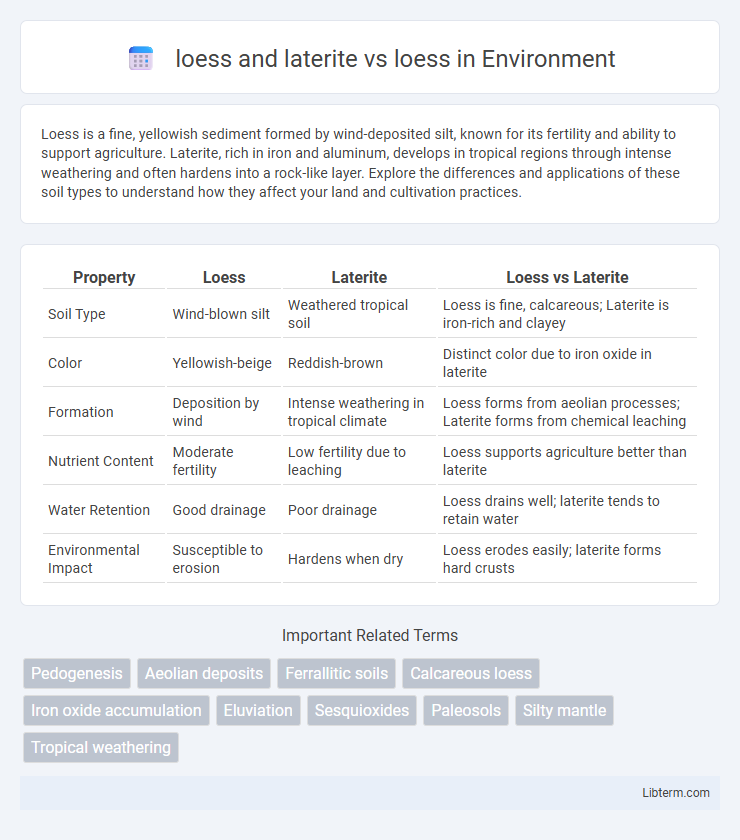Loess is a fine, yellowish sediment formed by wind-deposited silt, known for its fertility and ability to support agriculture. Laterite, rich in iron and aluminum, develops in tropical regions through intense weathering and often hardens into a rock-like layer. Explore the differences and applications of these soil types to understand how they affect your land and cultivation practices.
Table of Comparison
| Property | Loess | Laterite | Loess vs Laterite |
|---|---|---|---|
| Soil Type | Wind-blown silt | Weathered tropical soil | Loess is fine, calcareous; Laterite is iron-rich and clayey |
| Color | Yellowish-beige | Reddish-brown | Distinct color due to iron oxide in laterite |
| Formation | Deposition by wind | Intense weathering in tropical climate | Loess forms from aeolian processes; Laterite forms from chemical leaching |
| Nutrient Content | Moderate fertility | Low fertility due to leaching | Loess supports agriculture better than laterite |
| Water Retention | Good drainage | Poor drainage | Loess drains well; laterite tends to retain water |
| Environmental Impact | Susceptible to erosion | Hardens when dry | Loess erodes easily; laterite forms hard crusts |
Introduction to Loess and Laterite
Loess consists of fine, wind-deposited silt particles that create highly fertile and easily erodible soil, primarily found in temperate regions. Laterite forms in tropical and subtropical climates through intense weathering and leaching, resulting in iron- and aluminum-rich soil with poor fertility despite its hardened structure. These distinct soil types contrast in origin, composition, and environmental suitability, impacting agricultural potential and land use.
Definition and Formation of Loess
Loess is a wind-deposited, fine-grained sediment composed primarily of silt-sized particles, often forming fertile soils through accumulation during the Quaternary period. It is characterized by its loose, porous texture and is typically associated with glacial outwash plains and arid regions where strong winds transport and deposit dust. In contrast, laterite is a highly weathered soil rich in iron and aluminum oxides, formed through intense tropical weathering and leaching processes.
Defining Laterite: Origin and Characteristics
Laterite forms from intense tropical weathering of parent rock, rich in iron and aluminum oxides, resulting in a reddish, porous soil with high clay content. Loess, composed primarily of wind-deposited silt-sized particles, contrasts with laterite by its pale color, high fertility, and loose, crumbly texture. Understanding laterite's origin highlights its poor nutrient retention and suitability for construction, unlike the agriculturally valuable loess.
Key Differences Between Loess and Laterite
Loess is a fine-grained, wind-blown sediment primarily composed of silt-sized particles, often forming fertile soils in temperate regions, while laterite is a highly weathered soil rich in iron and aluminum, typical of tropical climates and characterized by intense leaching. Loess deposits exhibit high porosity and calcium carbonate content, which enhance soil fertility and water retention, whereas laterite soils are hard, clay-like with poor nutrient availability due to heavy mineral depletion. The formation process differs significantly; loess results from aeolian sedimentation, whereas laterite forms through prolonged chemical weathering under warm, wet conditions.
Comparative Physical Properties: Loess vs Laterite
Loess is a fine-grained, silty soil known for its high porosity, low density, and excellent drainage properties, whereas laterite is a dense, iron- and aluminum-rich soil characterized by low porosity and poor water permeability. The cohesion of laterite is significantly higher due to iron oxide cementation, contributing to its hardness and stability compared to the friable and crumbly texture of loess. Loess typically exhibits greater plasticity and susceptibility to erosion, while laterite demonstrates enhanced compaction and resistance to weathering processes.
Geographic Distribution of Loess and Laterite
Loess deposits are predominantly found in mid-latitude regions including the Midwest United States, parts of China, and Europe, formed from wind-blown silt during glacial periods. Laterite soils, rich in iron and aluminum, are extensively distributed in tropical and subtropical regions such as India, Southeast Asia, Africa, and South America, where intense weathering and high rainfall promote their formation. The geographic distribution highlights loess in temperate zones with arid to semi-arid climates, contrasting with laterite's prevalence in humid tropical climates.
Soil Fertility and Agricultural Significance
Loess, a highly fertile soil rich in minerals like calcium carbonate, supports robust crop growth due to its fine texture and excellent water retention properties. Laterite, in contrast, is characterized by high iron and aluminum oxides but low nutrient content, resulting in poor soil fertility that often requires significant amendments for sustainable agriculture. The superior fertility of loess makes it more suitable for diverse and intensive farming compared to the nutrient-deficient, acidic laterite soils commonly found in tropical regions.
Erosion and Environmental Impacts
Loess is highly susceptible to erosion due to its fine, loosely packed silt particles, leading to significant soil loss and sedimentation in nearby waterways. Laterite, with its dense, iron-rich composition, exhibits greater resistance to erosion but can cause environmental issues such as poor drainage and reduced soil fertility. The contrasting erosion dynamics between loess and laterite soils influence sustainable land management and conservation strategies in affected regions.
Engineering Properties: Loess vs Laterite
Loess exhibits high porosity and low cohesion, making it susceptible to collapsing and differential settlement when saturated, which challenges foundation stability. Laterite boasts higher strength and better load-bearing capacity due to its cemented structure and lower permeability, ideal for construction in tropical regions. Engineering designs favor laterite for its durability, while loess requires cautious soil stabilization techniques to mitigate risk.
Summary Table: Loess and Laterite Comparison
Loess and laterite differ significantly in composition and formation; loess is a fine, wind-blown silt primarily consisting of quartz, feldspar, and mica, while laterite is a highly weathered soil rich in iron and aluminum oxides. Loess forms in arid to semi-arid regions with low organic content, whereas laterite develops in tropical, humid climates with intense chemical weathering. The Summary Table highlights loess as fertile and porous with high water retention compared to laterite's compact, nutrient-poor structure that requires improvement for agriculture.
loess and laterite Infographic

 libterm.com
libterm.com